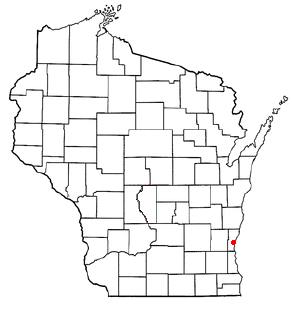Grafton (town), Wisconsin

Grafton is a town in Ozaukee County, Wisconsin, United States. The population was 4,132 at the 2000 census. The Town of Grafton is located about 20 miles north of downtown Milwaukee on the shore of Lake Michigan. It is east of the village of Grafton and the Town of Cedarburg, south of the Town of Port Washington, and north of the city of Mequon. The unincorporated communities of Lakefield, and Ulao are located in the town.
History
Historically, one of the more important settlements was the community of Ulao, Wisconsin. It was located at the eastern end of the road which became State Highway 60.
The Town of Grafton was the site of Camp Hindenburg, owned and operated by the pro-Nazi German American Bund from the late 1930s through the outbreak of World War Two. In 1940, Camp Carl Schurz, operated by the anti-Bund Wisconsin Federation of German-American Societies, was opened a mile away.[1][2][3]
Geography

According to the United States Census Bureau, the town has a total area of 21.4 square miles (55.5 km²), of which, 19.8 square miles (51.3 km²) of it is land and 1.6 square miles (4.1 km²) of it (7.47%) is water.
Landmarks
The Kevich Light is located in the town.
Demographics
As of the census[4] of 2000, there were 4,132 people, 1,569 households, and 1,241 families residing in the town. The population density was 208.5 people per square mile (80.5/km²). There were 1,608 housing units at an average density of 81.1 per square mile (31.3/km²). The racial makeup of the town was 98.02% White, 0.34% Black or African American, 0.22% Native American, 0.48% Asian, 0.10% Pacific Islander, 0.34% from other races, and 0.51% from two or more races. 1.11% of the population were Hispanic or Latino of any race.
There were 1,569 households out of which 33.5% had children under the age of 18 living with them, 71.5% were married couples living together, 5.0% had a female householder with no husband present, and 20.9% were non-families. 16.1% of all households were made up of individuals and 4.8% had someone living alone who was 65 years of age or older. The average household size was 2.63 and the average family size was 2.98.
In the town, the population was spread out with 24.7% under the age of 18, 5.9% from 18 to 24, 28.0% from 25 to 44, 31.2% from 45 to 64, and 10.2% who were 65 years of age or older. The median age was 41 years. For every 100 females, there were 104.6 males. For every 100 females age 18 and over, there were 101.2 males.
The median income for a household in the town was $64,707, and the median income for a family was $73,125. Males had a median income of $42,320 versus $35,446 for females. The per capita income for the town was $30,582. About 4.0% of families and 5.1% of the population were below the poverty line, including 6.4% of those under age 18 and 8.0% of those age 65 or over.
References
- ^ Gurda, John (1999). "7". The Making of Milwaukee. Milwaukee: Milwaukee County Historical Society. p. 307.
- ^ "Flag is Hoisted at Bund Camp", The Milwaukee Journal May 31, 1940, p. 13, col. 2.
- ^ United States. Congress. House. Special Committee on Un-American Activities (1938-1944) Investigation of un-American propaganda activities in the United States. Hearings before a Special Committee on Un-American Activities, House of Representatives, Seventy-fifth Congress, third session-Seventy-eighth Congress, second session, on H. Res. 282, to investigate (l) the extent, character, and objects of un-American propaganda activities in the United States, (2) the diffusion within the United States of subversive and un-American propaganda that is instigated from foreign countries or of a domestic origin and attacks the principle of the form of government as guaranteed by our Constitution, and (3) all other questions in relation thereto that would aid Congress in any necessary remedial legislation (1941): Appendix, pt. 4 - German-American Bund Washington, DC: US Government Printing Office, 1942.
- ^ "American FactFinder". United States Census Bureau. Archived from the original on 2013-09-11. Retrieved 2008-01-31.
{{cite web}}: Unknown parameter|deadurl=ignored (|url-status=suggested) (help)

